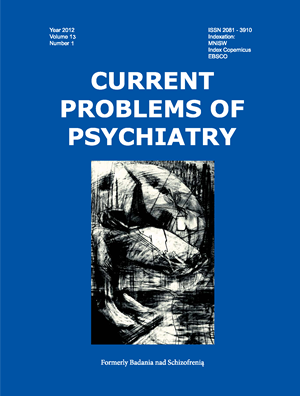Culture and mental disorders
Keywords:
cultural psychiatry, ethnopsychiatryAbstract
Cultural psychiatry is an area of psychiatry focusing on epidemiology, etiology, pathogenesis, symptomatology and treatment of psychiatric disorders taking into account the influence of culture and environmental conditions. The term cultural psychiatry is superior to terms transcultural psychiatry, comparative psychiatry or ethnopsychiatry. Transcultural psychiatry focuses on the study of characteristics of mental disorders, whereas comparative psychiatry concentrates on the differences in psychopathology determined by cultural differences. The field of psychiatry called ethnopsychiatry (cultural psychiatry) focuses on studying the exotic types of mental disorders and establishing their possible connection with ethnic variables.
The aim of this article is to approach the issue connected to cultural psychiatry regarding the specific character of mental disorders, which are conditioned culturally or syndromes existing only in particular ethnic groups. Several distinctions in frequency and severity of particular symptoms can exist in many psychiatric disorders, such as schizophrenic psychosis, mood disorders, anxiety disorders or addictions. Syndromes existing only in particular ethnic groups consist a very interesting topic. The best known ones include: koro, amok, dhat, latah and windigo.
References
1. Gaw A.C. Zagadnienia kulturowe. W: Hales R.E., Yudofsky S.C., Gabbard G.O. red., Psychiatria Tom 1., Warszawa; Medipage: 2010, s. 307-333.
2. Barrio C., Culture and schizophrenia: A crossethnic growth curve analysis. J Nerv Mental Disease, 2001; 189 (10): 676-684.
3. Grzywa A. Oblicza psychozy. Lublin; Wyd. Czelej: 2005.
4. Jakubik A. Psychiatria kulturowa. W: Dąbrowski S., Jaroszyński J., Pużyński S. red. Psychiatria Tom 3., Warszawa; PZWL: 1989, s. 51-64.
5. Krzyżowski J. Psychiatria transkulturowa. Warszawa; Medyk: 2002.
6. Yap P.M. Comparative psychiatry: A theoretical Framework. Toronto; University of Toronto: 1974.
7. Wulff E. Ethnopsychiatrie. Wiesbaden; Akademische Verlagsge-sellsschaft:1978
8. Kirmayer L.J., Young A. Culture and somatization: Clinical, epidemiological, and ethnographic perspective., Psychosom Med, 1998; 60: 420-430.
9. Eliade M. Aspekty mitu. Warszawa; Wyd. KR: 1998.
10. Grzywa A. Pogranicza psychiatrii. Lublin; Wyd. Czelej: 2009.
11. Parrot A. Kac po ekstazie. Charaktery, 2009; 8: 88-91.
12. Bernstein R.L., Gaw A.C. Koro: proposed classification for DSM-IV. Am J Psychiatry, 1990 ;147(12):1670-4.
13. Montgomery C. Bóg Rekin. Wyprawa do źródeł magii. Warszawa; Świat Książki: 2007.
14. Quinlan M.B. Ethnomedicine and ethnobotany of fright, a Caribbean culture-bound psychiatric syndrome. J Ethnobiol Ethnomed, 2010;17(2): 6-9.
15. Kenny M.G. Latah: the symbolism of a putative mental disorder. Cult Med Psychiatry, 1978;2(3):209-31.
16. Hatta S.M. A Malay crosscultural worldview and forensic review of amok. Aust N Z J Psychiatry, 1996; 30(4):505-10.
17. Sumathipala A., Siribaddana S.H., Bhugra D. Culture-bound syndromes: the story of dhat syndrome. The British Journal of Psychiatry, 2004;184:200-209.
18. El-Mallakh R.S. Schizophrenia and the origins of shamanism among the Kwakiutl maritime cultures of Northwest North America: A hiothesis. Schizophrenia Res, 2006; 86: 329-330.


